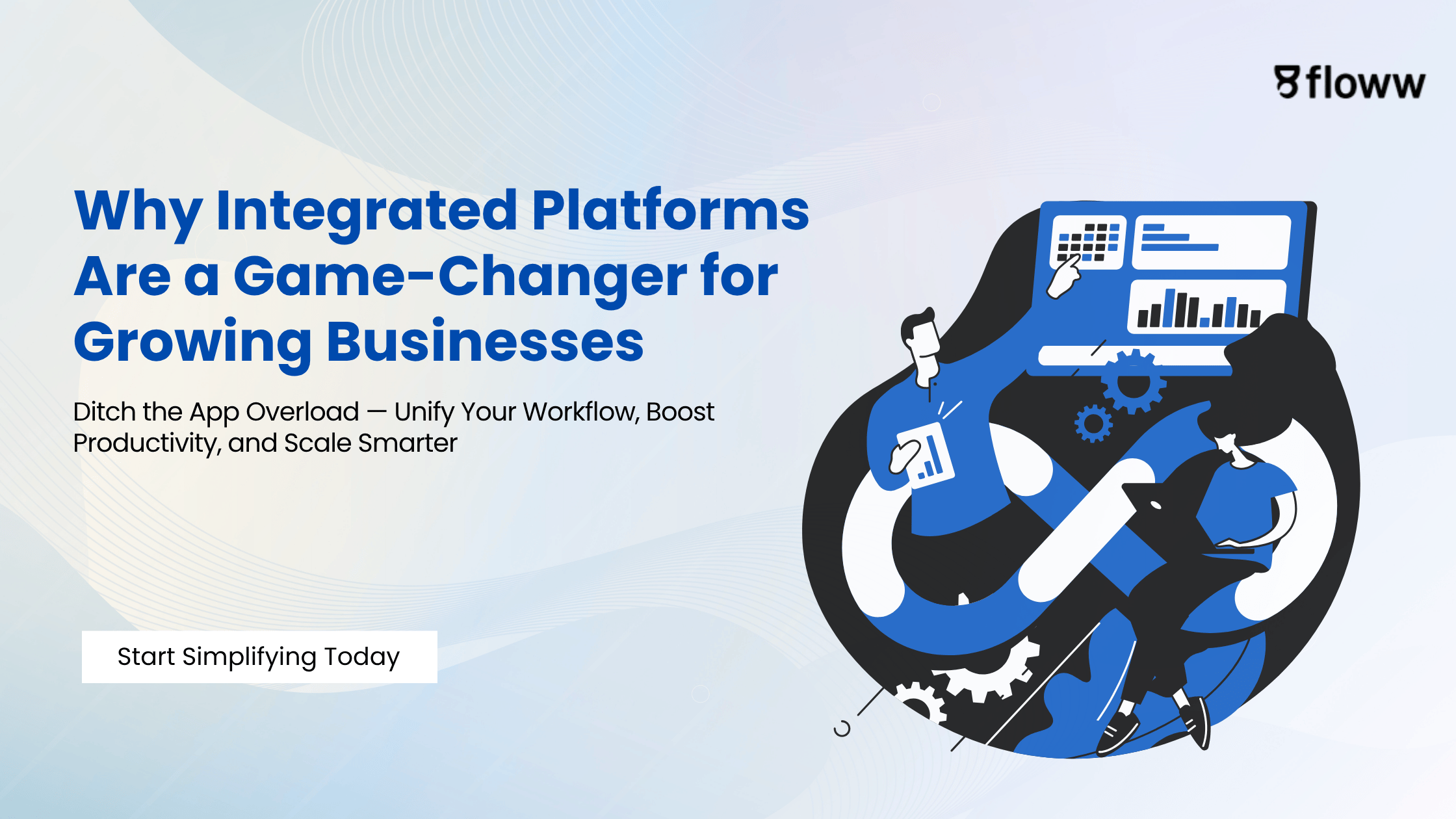Why Integrated Platforms Are Changing the Game for Growing Businesses
Juggling 10 different tools to run one business? That’s old news. Integrated platforms are the new MVP. They cut through chaos and give growing businesses the clarity and control they crave. It’s not just smarter tech. It is a whole new way to scale.

When small businesses start dreaming big, several problems start coming along. For instance, suddenly, five different tools aren’t enough. You find an HR platform over here, a payroll tool over there, a separate app for attendance, and don’t even get started on finance.
Before you know it, your team is busy jumping from tab to tab instead of focusing on the core business. In MSMEs, when each system speaks its own language, things fall through the cracks, and productivity stalls.
Wide-eyed startups and growing MSMEs know exactly what we are talking about.
Sustaining growth becomes an uphill battle when systems don’t talk to each other. But this problem doesn’t require more apps, it requires smarter systems that unify and amplify. And this is where we need integrated platforms built for growth, communication, and simplification.
The Transition From Fragmented Tools To One Unified System

Imagine a business day without context-switching fatigue. No more struggling to find a contractor’s payslip or hunting for leave approvals buried in emails. With an integrated platform, everything lives in one place, and the pieces just click.
These platforms typically bundle together crucial business needs. Your business gets HR, payroll, attendance, finance, and communication all into a cohesive whole. Your employees no longer jump through tabs but work in an uninterrupted rhythm. Approvals happen within the same interface where the request was made. Timesheets feed directly into payroll. HR joins forces with finance on a single dashboard.
And even though the myth continues, this is not a feature overlap. This is exactly what workflow integration is. Every process becomes part of one connected experience. It is designed to make your day flow smoother, faster, and without friction.
Why Growth Demands More Than Just Tools

Growth accelerates friction.
A team of five can get away with sending payslips manually. A team of fifty cannot. As the business starts growing, the crack begins to show. What was once manageable with a team of five, now starts draining time, energy and focus.
The problem isn’t tools. Adding more tools doesn’t scale unless they’re connected logically. When data is scattered, everything gets slower. Onboarding new staff becomes difficult, issuing invoices becomes a hassle, closing payroll and even responding to customers feels tiring. Growing businesses need environments where the tech anticipates the flow, not interrupts it.
In integrated platforms information flows seamlessly. This increases accuracy, increasing clarity. The game isn't just about automation, it’s about orchestration. And that’s where the magic happens.
The Power of Data Working in Harmony
It’s one thing to automate tasks, and another to wield data as a strategic ally. Integrated platforms collect data across every function and then display it cohesively. Seeing team capacity, workload distribution, and cost trends in one dashboard is strategic.
This transforms data from stagnant spreadsheets into living insights. You can understand which teams are stretched, which projects are costing you too much, and where communication is locking up. As your business scales, so does your confidence in knowing what’s working and what isn't.
Read More: What we have built in 3 years
No More Email Chaos or Document Overload
Picture the last time someone asked for an official document. Say, the attendance record of a star employee or a payslip from three months ago. Did you search shared drives? Scroll through emails? If yes, you know the pain.
Integrated platforms do the opposite. Every record, be it payroll, attendance, expense, or leave is part of a searchable, permanent archive. Data becomes a living library. Onboarding becomes smooth, audits become easy, and historical gaps become a thing of the past.
Also Read: The true cost of poor leave management
Human-Centric Design Meets Business Logic

What really sets the best platforms apart is human-focused design wrapped in technical power.
This design philosophy was central to Floww’s Atom Suite. Rather than dumping calendars, spreadsheets, and approval queues into one UI, Atom Suite is built for real users. Think of it this way- an HR manager who just wants to check if someone took leave or perhaps a sales rep who wants to send an invoice in a single click. That is how exactly Atom Suite delivers.
Explore Atom Suite. Take a Free Demo Today!
Real-Time Presence Without Headaches
In India, “attendance” means more than punching in. It can really make or break payroll accuracy. Traditional systems rely on separate biometric devices that then need manual uploads into payroll software. It’s complex, error-prone, and a constant admin burden.
An integrated platform transforms this. Biometric data syncs in real-time with personnel records and payroll. No file transfers, no manual imports. Presence automatically maps to leave accrual, attendance policy, and salary cycles. For growing teams, it’s like having an always-on operations team behind the scenes.
Streamlined Payroll Without the Headaches
As soon as a new employee joins, payroll becomes active. You need a system flexible enough to handle changes. Keep a note of starting dates, attendance exceptions, reimbursements, all without glitches. But once payroll is disconnected from HR or attendance, small changes become domino effects.
Integrated tools align everything. Payroll rules update automatically when leave is approved. Billing rates sync with invoiced hours. With fewer manual touchpoints, error rates plummet and compliance is baked in. For growing businesses, payroll feels less like a chore and more like a reliable engine powering people’s hard work.
Choosing the Right Integrated Platform

With every business pitching integration, how do you pick one that’s built for impact? Here’s what matters (without sounding like a generic checklist).
First, it has to feel familiar. Using a tool shouldn’t feel like learning to pilot a rocket. Interfaces should feel intuitive and light, even for non-technical staff.
Then, it needs to stay modular. Your business today may not need finance modules, but might later. Systems that allow you to add features, instead of forcing them, scale better with you.
Third, integration should be behind the scenes. You shouldn’t see errors. Data should simply flow.
And finally, human empathy should outshine everything else. The best systems aren’t just built by coders in cafes. They are built with small business owners, accountants, HR teams, and startup founders in beta groups. They speak your language (literally). They reflect your licenses, policies, norms, and financial calendars.

